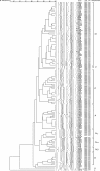Strain variation among Bordetella pertussis isolates circulating in Poland after 50 years of whole-cell pertussis vaccine use
- PMID: 21307213
- PMCID: PMC3122874
- DOI: 10.1128/JCM.01487-10
Strain variation among Bordetella pertussis isolates circulating in Poland after 50 years of whole-cell pertussis vaccine use
Abstract
In the present study, clinical isolates of Bordetella pertussis collected in Poland from 1960 to 2005 were analyzed by pulsed-field gel electrophoresis (PFGE) according to protocols recommended in previous studies. Among the 110 isolates from 1995 to 2005, 59 PFGE patterns were found, most of which were different from those currently circulating in other European Union (EU) countries for which data are available. The PFGE patterns of currently disseminating B. pertussis clones were found within PFGE groups III and IV, as elsewhere in the EU, and in newly identified clusters A and C. Up to 70, 26, and 4%, respectively, of the currently isolated strains in Poland harbored ptxA1-prn1, ptxA1-prn2, and ptxA1-prn3 allele combinations, and most (82%) were found to be of the Fim2 phenotype. Differences in the extent of heterogeneity estimated by PFGE typing in B. pertussis populations circulating in Poland in comparison to other EU countries may be due to the different vaccine composition strategy, since routine pertussis vaccination was initiated in Poland in 1960.
Figures

Similar articles
-
Sequence variation in virulence-related genes of Bordetella pertussis isolates from Poland in the period 1959-2013.Eur J Clin Microbiol Infect Dis. 2015 Jan;34(1):147-152. doi: 10.1007/s10096-014-2216-6. Epub 2014 Aug 5. Eur J Clin Microbiol Infect Dis. 2015. PMID: 25090968
-
Multi-locus variable-number tandem repeat analysis of Bordetella pertussis isolates circulating in Poland in the period 1959-2013.J Med Microbiol. 2017 Jun;66(6):753-761. doi: 10.1099/jmm.0.000408. Epub 2017 Jun 9. J Med Microbiol. 2017. PMID: 28598302
-
Pertactin-deficient Bordetella pertussis isolates in Poland-a country with whole-cell pertussis primary vaccination.Microbes Infect. 2019 Apr-May;21(3-4):170-175. doi: 10.1016/j.micinf.2018.12.001. Epub 2018 Dec 21. Microbes Infect. 2019. PMID: 30580013
-
Bordetella pertussis strain variation and evolution postvaccination.Expert Rev Vaccines. 2009 Jul;8(7):863-75. doi: 10.1586/erv.09.46. Expert Rev Vaccines. 2009. PMID: 19538113 Review.
-
Epidemiology of whooping cough & typing of Bordetella pertussis.Future Microbiol. 2013 Nov;8(11):1391-403. doi: 10.2217/fmb.13.111. Future Microbiol. 2013. PMID: 24199799 Review.
Cited by
-
Genetic Profile Variation in Vaccine Strains and Clinical Isolates of Bordetella pertussis Recovered from Iranian Patients.Avicenna J Med Biotechnol. 2014 Jul;6(3):178-84. Avicenna J Med Biotechnol. 2014. PMID: 25215182 Free PMC article.
-
Virulence Factors Variation Among Bordetella Pertussis Isolates in Iran.Int J Mol Cell Med. 2015 Spring;4(2):138-42. Int J Mol Cell Med. 2015. PMID: 26261803 Free PMC article. No abstract available.
-
Characterization of Bordetella pertussis Strains Isolated from India.Pathogens. 2022 Jul 14;11(7):794. doi: 10.3390/pathogens11070794. Pathogens. 2022. PMID: 35890038 Free PMC article.
-
Analysis of Bordetella pertussis clinical isolates circulating in European countries during the period 1998-2012.Eur J Clin Microbiol Infect Dis. 2015 Apr;34(4):821-30. doi: 10.1007/s10096-014-2297-2. Epub 2014 Dec 20. Eur J Clin Microbiol Infect Dis. 2015. PMID: 25527446 Free PMC article.
-
Genome diversity and evolutionary characteristics of clinical isolates of Bordetella pertussis circulating in Iran.Iran J Microbiol. 2020 Feb;12(1):1-10. Iran J Microbiol. 2020. PMID: 32322373 Free PMC article.
References
-
- Advani A., Donnelly D., Gustafsson L., Hallander H. O. 2007. Changes of the Swedish Bordetella pertussis population in incidence peaks during an acellular pertussis vaccine period between 1997 and 2004. APMIS 115:299–310 - PubMed
-
- Advani A., Gustafsson L., Carlsson R.-M., Donnelly D., Hallander H. 2007. Clinical outcome of pertussis in Sweden: association with pulsed-field gel electrophoresis profiles and serotype. APMIS 115:736–742 - PubMed
-
- Advani A., van der Heide H. G. J., Hallander H. O., Mooi F. R. 2009. Analysis of Swedish Bordetella pertussis isolates with three typing methods: characterization of an epidemic lineage. J. Microbiol. Methods 78:297–301 - PubMed
Publication types
MeSH terms
Substances
LinkOut - more resources
Full Text Sources
Medical
Molecular Biology Databases

